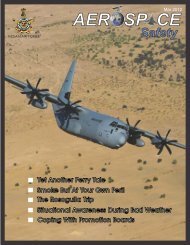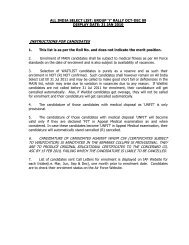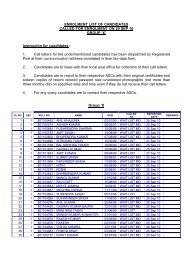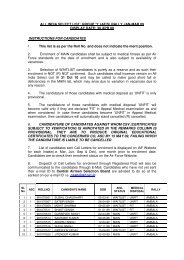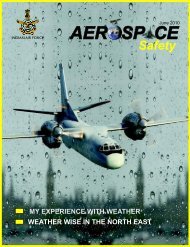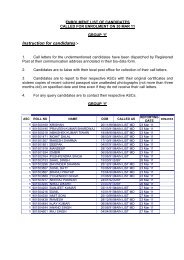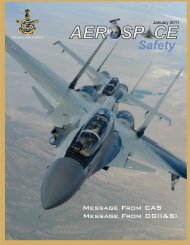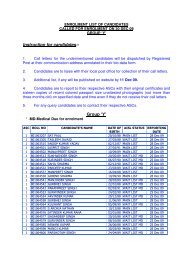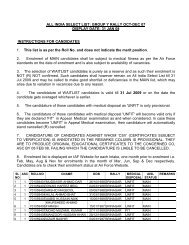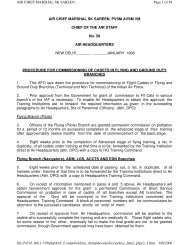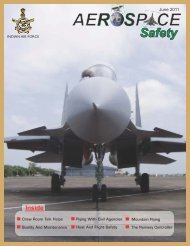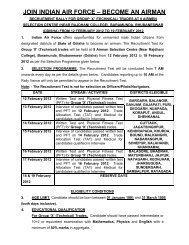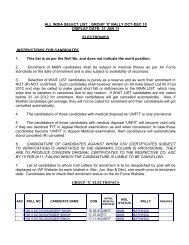Create successful ePaper yourself
Turn your PDF publications into a flip-book with our unique Google optimized e-Paper software.
After my Stage 3 training on Kiran MK-II<br />
aircraft, I was posted to my first Fighter<br />
Squadron at a premier Fighter base in the<br />
West, for MOFT syllabus on MiG-21 T-96 aircraft.<br />
The morale was high and so were the spirits. The<br />
station housed two fighter squadrons operating<br />
the same type of aircraft. So, the atmosphere<br />
with 22 flying officers from Sem I & II wasn’t<br />
very different from that in Training Command.<br />
Every morning ushered in unlimited visibility<br />
and high serviceability; one could hear reheat<br />
after reheat, and it filled us with thrill. Soon, my<br />
ground training was over and I commenced<br />
flying on what was called the real fighters. She<br />
was sleek and fast and could take anyone for a<br />
ride. The time on downwind got over in a flick<br />
and there was no time to get our parameters and<br />
carry out vital actions, leave alone the situational<br />
awareness on the circuit traffic. A few days later,<br />
the first guy in the course cleared his solo check<br />
and was launched in a fighter for his first solo.<br />
With most of us due for our solo checks in a few<br />
days, we proceeded along with the ACP pilot to<br />
see the first solo landing of our course. He was<br />
our very own - Callsign 919.<br />
After about 20 mins, we heard Callsign 919<br />
on R/T for the rejoin. He reported dead side and<br />
turned downwind. In the first overshoot, he was<br />
correctly on glide path, after which he turned<br />
for downwind. In this time, Prowler formation<br />
that had gone for a Basic Flying Manoeuvres<br />
sortie to the sector, too had rejoined. Prowler<br />
– 2, a Sem II trainee, joined circuit behind 919,<br />
and the leader maintained overhead to regulate<br />
gravy. 919 reported downwind, followed by<br />
Prowler 2. I picked him up visually on finals - but<br />
wait a second! These were two aircraft in close<br />
proximity!! 919 while carrying out his downwind<br />
vital actions had delayed his baseleg turn and<br />
Prowler – 2 had turned at the correct baseleg<br />
turning point. As a result when prowler-2 rolled<br />
out on finals he was dangerously close to 919.<br />
The ATC in a panic, gave a call to Prowler-2 to go<br />
around and 919 to continue. However 919 also<br />
initiated go around in a panic. The ACP pilot<br />
intervened and told Prowler-2 to go around on<br />
dead side. On seeing 919 in such close proximity<br />
while going around, Prowler-2 put on a vicious bank<br />
with undercarriage and flaps down and yanked<br />
back towards dead side. The ACP pilot in a horror<br />
yelled on R/T to offload, but the aircraft with nose<br />
up and at very low speeds continued towards dead<br />
side and started a wild wing to wing rocking which<br />
is a symptom of approach of stall. But much to<br />
everybody’s relief, it thereafter gradually lowered<br />
nose, and spaced out to the correct dead side. Both<br />
aircraft were recovered safely subsequently.<br />
Lessons Learnt<br />
The first solo had no SA of any other aircraft<br />
on circuit; he was too busy carrying out his own<br />
checks and maintaining parameters as accurately as<br />
possible.<br />
Prowler – 2, a Sem II trainee, happily assumed<br />
that the traffic ahead would be maintaining correct<br />
circuit pattern and was taken by surprise when he<br />
saw the aircraft ahead going around.<br />
The MiG-21 requires careful handling at<br />
low speeds and such incidents can be avoided by<br />
adhering to simple practices like making visual<br />
contact with traffic ahead, and if no contact, by<br />
confirming traffic on R/T.<br />
After both aircraft landed, ACP pilot said “This is<br />
exactly what you should NOT DO...Remember this<br />
Black Demo”.<br />
- Flt Lt K Sharma<br />
The day before our first para-jump, the<br />
instructor demonstrated all possible<br />
malfunctions that one might encounter.<br />
After watching a total malfunction,<br />
i.e. failure of the parachute to deploy, one<br />
of the students asked: “If we have a complete<br />
malfunction, how much time do we have to deploy<br />
our reserve parachute”<br />
The Instructor replied: “You have the REST of<br />
your life to deploy that reserve!”<br />
INDIAN AIR FORCE 2 0 1 2 J u n e Aerospace Safety 19



